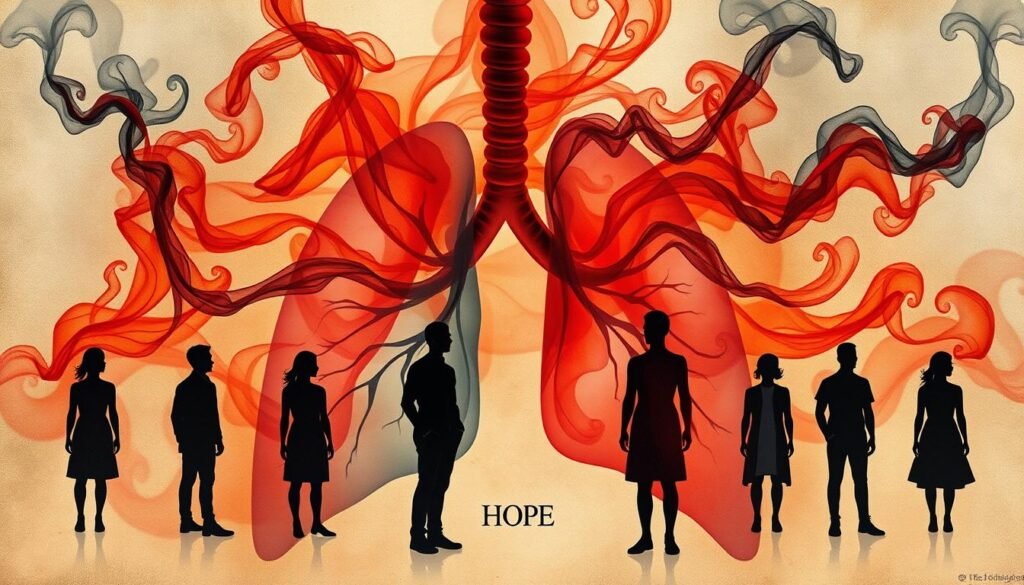About 85% of lung cancer cases are found when symptoms start to show. This fact shows a strong need for better early detection methods. Lung cancer is the top cause of cancer deaths in the United States. So, the question of whether blood tests can spot lung cancer early is very important. In this piece, we’ll look at how blood tests could help with non-invasive cancer checks.
We will compare them to older ways of diagnosing cancer. We will also discuss new technologies and the crucial role of finding cancer early. This will give readers a full picture of this important issue.
Key Takeaways
- 85% of lung cancers are diagnosed when symptoms appear, highlighting the need for earlier detection methods.
- Only 6% of eligible individuals undergo regular low-dose CT screening despite its mortality reduction benefits.
- Current lung cancer diagnoses rely heavily on imaging tests and various biopsy methods.
- Ongoing research explores the effectiveness of blood tests in the early detection of lung cancer.
- Integrating blood tests with existing diagnostic techniques may transform lung cancer screening.
- Identifying biomarkers through blood tests presents a promising frontier in cancer diagnostics.
The Importance of Early Detection in Lung Cancer
Lung cancer is the top killer among cancers in the U.S. Early detection is key to fighting it. This battle counts for almost 20% of all cancer deaths. Knowing how early discovery works helps save lives and improve treatment success.
Statistics on Lung Cancer Mortality
Lung cancer ranks second in common cancers, says the American Cancer Society. Sadly, only 21% are found early. This shows we need better tests. Low-dose CT scans help spot cancer early in heavy smokers aged 50 to 80. This method lowers death rates.
The Role of Early Diagnosis in Treatment Success
Spotting cancer early means treatments work better. A big study found screening cuts lung cancer deaths by 20%. LDCT scans catch cancer soon, leading to easier treatments.
Talking to a doctor about screenings is vital for people at risk. Knowing about tests like LDCT scans and blood tests can fight lung cancer deaths. For more on early detection, click here.
Traditional Methods of Lung Cancer Diagnosis
To diagnose lung cancer, doctors follow a step-by-step method. They start with imaging tests to find lung issues. Knowing these methods helps with early detection and treatment.
Imaging Tests: X-rays and CT Scans
Imaging tests are key for spotting lung cancer. Chest X-rays give a quick look at the lungs. CT scans offer more detailed pictures, showing even small tumors. People who smoked a lot should get yearly low-dose CT scans. Catching cancer early greatly increases the chance of beating it. More on this topic can be found here.
Tissue Biopsies: Different Methods Explained
Though imaging is helpful, tissue biopsies are often needed to confirm lung cancer. They check lung cells for signs of cancer. Methods range from needle biopsies to bronchoscopy. Techniques like mediastinoscopy and EBUS help get samples from deep within the lungs with little harm. Knowing these biopsy methods is crucial for planning the right treatment.
Can Lung Cancer Be Detected By Blood Test?
Scientists are finding new ways to detect lung cancer, focusing on blood tests. These tests look for signs of lung cancer in people who feel fine. They search the blood for specific markers that point to lung cancer.
Overview of Blood Testing for Lung Cancer
Blood tests for lung cancer could change future diagnosis methods. Right now, we use imaging like CT scans to find cancer early. But a simple blood test might tell us if cancer is there, even without symptoms. Studies suggest this could catch cancer early and improve chances of a good outcome.
Current Research Developments in Blood Tests
The race is on to find a dependable lung cancer blood test. Researchers are looking into cancer patient’s blood to find unique lung cancer signs. The National Cancer Institute’s studies have found methods that might predict survival rates. These methods use early detection through blood tests.
| Study Focus | Participants | Findings |
|---|---|---|
| Identifying Cancer Biomarkers | 25 patients with non-small cell lung cancer (NSCLC) | Developed predictive model for survival rates |
| Model Validation | 54 patients with NSCLC | Accurate prediction of five-year survival |
| Metabolomic Analysis | Over 400 patients with prostate cancer | Differentiated between indolent and aggressive cancers |
Future steps in lung cancer research could change how we detect the disease. This would mean less invasive testing for those at high risk. Lung cancer blood tests are moving us towards better diagnosis, early detection, and improved chances for patients.
Understanding Cancer Biomarkers
Cancer biomarkers are key in diagnosing lung cancer. These are biological molecules like proteins and genes. They show cancer’s presence in the body. Knowing about these markers helps in treating patients more effectively.
What Are Cancer Biomarkers?
Cancer biomarkers show different changes in cancer cells, such as mutations or DNA rearrangements. These changes can influence how well treatments work. Biomarker tests provide info about cancer’s traits. This helps doctors choose the best treatment. For instance, some drugs work best on cancers with certain gene changes. Biomarker tests can find these changes.
Examples of Lung Cancer Biomarkers
Many lung cancer biomarkers are used in medicine today. Tests for gene mutations like EGFR, ALK, and ROS1 help pick the right treatments. For advanced non-small cell lung cancer (NSCLC), almost half of the cases have a mutation that can be targeted. It’s crucial for doctors and patients to talk about the importance of biomarker tests. This ensures the right diagnosis and improves treatment results.
| Biomarker | Type of Change | Common Treatments |
|---|---|---|
| EGFR | Mutation | EGFR inhibitors |
| ALK | Rearrangement | ALK inhibitors |
| ROS1 | Rearrangement | ROS1 inhibitors |
| K-RAS | Mutation | Targeted therapy |
| HER2 | Amplification | HER2 inhibitors |
The Concept of Liquid Biopsy
A liquid biopsy marks a significant step forward in spotting cancer with a simple test. This method examines blood to find signs of cancer. It avoids the need for cutting into the body like older tests.
This makes it a key player in lung cancer care. It gives doctors valuable information. This can change how a patient is treated.
What Is a Liquid Biopsy?
Liquid biopsy checks body fluids, mainly blood, for cancer signs. It looks for cancer cells and DNA that are floating around. This is easier and hurts less than traditional methods that require cutting into the body.
It also allows doctors to see how well treatment is working. They can also use it to spot cancer coming back. This is important for tailoring care to each patient.
Advantages Over Traditional Biopsies
Liquid biopsies have clear benefits over the old ways:
- Minimally Invasive: They are less scary and safer than operations.
- Rapid Results: They work fast, helping doctors make quick decisions for treatment.
- Comprehensive Analysis: They can find many cancer signs, giving a complete picture of the cancer.
- Monitoring Capabilities: They allow for ongoing checks to see if a treatment is working or if the cancer is growing.
Using liquid biopsy for lung cancer can really improve how well patients do.
Recent Advances in Blood-Based Cancer Tests
Recent developments in blood-based cancer tests are very promising for early lung cancer detection. New technologies like protease enzyme detection are transforming diagnosis methods. They offer less invasive options for patients.
Protease Enzyme Detection Technology
Protease enzyme detection has become a key method for identifying lung cancer with about 90% accuracy. This breakthrough helps doctors find tumors early, which is key since lung cancer causes many cancer deaths. Research by Bossmann and Covarrubias-Zambrano is making blood tests affordable. They might soon cost as much as a CT scan.
Circulating Tumor DNA and Its Implications
The study of circulating tumor DNA is showing promise. It can reveal cancer progression and treatment responses. Circulating tumor DNA studies offer insights into mutations after treatment. Liquid biopsies for various cancers make these tests even more useful.

| Technology | Accuracy | Result Turnaround Time | Cost Comparison |
|---|---|---|---|
| Protease Enzyme Detection | 90% | Hours | Cheaper than CT scan |
| Circulating Tumor DNA Analysis | Varies | Variable | Pending standardization |
There’s a gap in CT scan screenings; only 6% of those at risk get screened annually. Blood tests are improving how we diagnose cancers, laying the basis for more research. They help compare these new methods to old ones. For more, read this detailed article.
Limitations of Blood Tests for Lung Cancer
Blood tests can give helpful insights but have big limitations in spotting lung cancer. Tests like X-rays and biopsies are better for finding this disease. Knowing the limitations of blood tests helps doctors and patients make better choices.
False Positives and False Negatives
One big issue is false positives. This means a test may say there is cancer when there isn’t. It can cause a lot of worry and lead to more tests that aren’t needed. On the other hand, false negatives can happen too, missing the detection of cancer. These errors show the tough parts of diagnosing lung cancer. They stress the need for using more than one way to check for this illness.
Situations Where Blood Tests May Not Be Reliable
There are times when blood tests might not tell the full story. They often miss early-stage cancers and smaller tumors. So, better options, like liquid biopsies or special imaging, may be needed. Knowing these limits can help patients get the right diagnosis faster. It shows why it’s important to use different ways to find lung cancer.
Impact of Smoking on Lung Cancer Detection
Smoking is a key risk factor for lung cancer, greatly increasing risk. A shocking fact is that 90% of lung cancer deaths are due to smoking or secondhand smoke. Smokers are about 25 times more likely to get lung cancer than non-smokers. This shows quitting smoking is crucial to lower lung cancer risks.
Statistical Risks of Lung Cancer in Smokers
In 2018, lung cancer caused roughly 1,761,000 deaths worldwide. This was 18.4% of all cancer deaths. The survival rate for lung cancer is sadly only 20% after five years, much lower than other cancers’ 70% rate. Most lung cancer cases are found late, which makes treatment harder. Up to 25% of cases occur in people who never smoked. Mostly, these are adenocarcinomas, showing lung cancer’s varied nature.
Screening Recommendations for Smokers
The U.S. Preventive Services Task Force recommends yearly low-dose CT scans for 50 to 80-year-olds who smoked a lot. Screenings can greatly help, as shown by a 92% 5-year survival rate if detected at stage IA. New methods like biomarkers and liquid biopsy could improve screening. These advancements stress the need for careful screening for smokers to better outcomes and lower death rates.

The Future of Lung Cancer Screening
The future looks bright for lung cancer screening. New developments could greatly improve how we detect the disease and care for patients. Now, we’re looking at combining advanced blood tests with tried-and-true methods. This could lead to catching the disease earlier and providing better care.
Potential of Combining Blood Tests with Other Methods
Combining a blood-based four-protein panel (4MP) with the lung cancer risk model (PLCOm2012) is showing promise. This approach is better at finding those at high risk of lung cancer death than the standard criteria. In one study, about 70% of those who developed lung cancer and passed away from it were identified within six years before diagnosis.
This new way of diagnosing could sharpen our ability to tell who might get lung cancer. It means we could catch the disease earlier in more people. Globally, this could help millions more be eligible for lung cancer screening.
Impacts on Patient Care and Outcomes
Lung cancer is a major cause of cancer deaths worldwide. Better screening methods can lead to early treatment, tailored to each patient. Using these new diagnostic methods, we can find the disease sooner. This helps avoid unnecessary tests for those not at risk.
With new screening strategies like low-dose CT (LDCT) scans, patients are getting better care. Trials have shown that these methods can lower the rate of death from lung cancer. This marks a shift towards more proactive patient care, making early detection crucial for saving lives.
| Study | Findings |
|---|---|
| NLST | 20% decrease in lung cancer-related mortality after 6.5 years with annual LDCT |
| NELSON | 24% lower death rate in screened men after 10 years |
| Beijing I-ELCAP | 76% of lung cancers diagnosed through LDCT at early stages |
| DEPISCAN | LDCT detected 8 lung cancers compared to 1 with chest X-ray |
| MILD Study | Hazard ratio of 0.61 indicating reduced 10-year mortality risk with LDCT |
| 2021 USPSTF Criteria | Recommend LDCT for adults aged 50-80 with 20 pack-year smoking history |
Patient Experiences and Stories
Real-life stories from lung cancer patients shed light on their journey through diagnosis and treatment. They tell us about the ups and downs of finding out early or too late. These stories underline how crucial timely screenings are for better chances of survival. They also talk about the emotional and practical challenges these patients face.
Anecdotes of Early Detection Success
Early detection can be a beacon of hope. Patients caught at the start often do much better. In fact, if lung cancer is found in Stage I or II, the chance of living more than five years jumps over 65%.
This success comes from better awareness and newer ways to diagnose. It leads to treating the disease sooner rather than later.
- Getting diagnosed early often leads to more effective treatments, making patients feel relieved.
- Thanks to new tech like the RaDaR™ liquid biopsy, care can be tailored to each patient.
- Regular check-ups and open talks with doctors have helped many catch the disease early.
Challenges Faced in Lung Cancer Diagnosis
There are hurdles, too, in recognizing lung cancer. Sometimes, early symptoms are misread, delaying the diagnosis. In the UK alone, 48,500 people get this diagnosis each year. Sadly, only a few are spotted early. The fact that 35,100 die from it each year shows the stakes of missing early signs.
“I ignored my symptoms, thinking I was just tired. When I finally got checked, it was advanced cancer. This taught me the value of being aware.”
Even with better screenings and research, backed by £45,000 from the Medical Research Council, challenges persist. Patients talk about the wait and the worry before finally getting their diagnosis.

| Challenges | Impacts |
|---|---|
| Misinterpretation of Symptoms | Delayed diagnosis leading to advanced stages at diagnosis |
| Limited Access to Regular Screenings | Fewer early detection opportunities |
| Emotional Strain During Waiting Periods | Increased anxiety and uncertainty for patients |
The stories from those fighting lung cancer highlight how important it is to keep pushing for better education, support, and ways to find the disease early.
Healthcare Recommendations for At-Risk Individuals
If you’re at risk, especially with a smoking habit or family lung cancer history, following health advice is key. Practices like checking lung health can greatly help with early cancer detection and improving treatment chances.
Best Practices for Monitoring Lung Health
It’s important not to skip regular health checks and lung monitoring. Here are crucial steps:
- Annual low-dose CT scans for individuals aged 50 to 80 years with a significant smoking history.
- Watching for changes in your breathing, like a constant cough or feeling out of breath.
- Learning about biomarker tests to find lung cancer’s genetic factors, helping to choose the right treatment.
- Remembering that even former smokers can still get lung cancer, making it vital to keep checking your health.
Consultation with Healthcare Professionals
Talking to healthcare pros is vital for people at risk. Open chats about your symptoms and risks help you get the right checks. Doctors can give advice tailored to you on:
- Who needs screening, especially if you smoked a lot in the past.
- How to handle side effects from cancer treatments.
- Where to find help, like the LUNGevity Lung Cancer HELPLine for support.
Conclusion
Research into lung cancer detection is making big strides. The discovery of 33 biomarkers for early detection is a game changer. These markers can spot Non-Small Cell Lung Cancer (NSCLC) with 90% accuracy. Focusing on just 21 of these biomarkers could make early detection even more reachable.
The new Lung Cancer Detector Test 1 (LCDT1) shows 95.6% accuracy. This gives hope for better screening methods. Early detection means patients can start treatment sooner, stopping the disease from getting worse.
Traditional screenings like low-dose computed tomography (LDCT) are still suggested. But, only 5% to 10% of people follow through with these tests. We need to boost health awareness to change this. Catching lung cancer early can greatly increase survival chances. For example, finding it at Stage I means over 55% chance of survival after five years. In late stages, that chance drops to under 5%.
New technology and methods are improving lung cancer detection. Machine learning and better data handling are making tests more reliable. Recognizing the signs of cancer early on is critical. Raising health awareness and using these new tools together can save lives. Especially for those at higher risk of lung cancer.